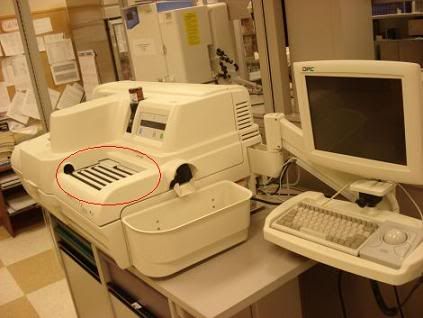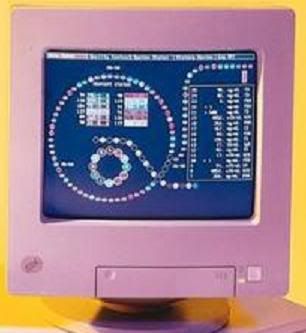Today, I’m going to explain to you all about an analyzer called IMMULITE, its principle and application. =D
Applications
This analyzer can carry out different tests at the same time. For examples, cortisol test, progesterone test, estradiol test, testosterone test. (These are just a few examples). The analyzer is able to measure the concentration of a compound of interest inside a sample. It is able to provide us a preliminary diagnosis or value to check for any abnormalities. (E.g. you can measure progesterone concentration in patients’ serum to check for their reproduction function or measure the insulin concentration to determine whether the person has diabetes). It is not a confirmatory test.
The test you want to carry out depends on the reagents that you have. For example, I had carried out cortisol test using this analyzer. So, I was given a box containing all the reagents that I needed for cortisol test. (The box is specifically for cortisol test). Different tests have their own boxes.
In each box, there is:
1. Test units (Barcode-labelled unit that contains one bead coated with antibody)
• For cortisol test: Cortisol test unit is used. It contains one bead coated with polyclonal rabbit anti-cortisol.
2. Reagent Wedge (Barcode-labelled unit that contains 7.5ml of enzyme conjugated to compound of interest)
• For cortisol test: Cortisol reagent wedge is used. It contains 7.5ml of alkaline phosphatase (bovine calf intestine) conjugated to cortisol)
• This is the labeled antigens
3. Adjustors (Two vials of adjustors are provided for each test, one high and one low adjustors, each contains 3ml of compound of interest)
• For cortisol test: Cortisol adjustors are used. Each contains 3ml of cortisol.
• Adjustor is like a calibrator which calibrates and ensures that the analyzer is functioning well before we carry out any test. Low adjustor will yield low level of result and high adjustor will yield high level of result.
4. Sample Diluent (One vial contains 25ml of processed human serum with the absence of compound of interest)
• For cortisol test: Cortisol sample diluent is used. It contains 25ml of processed cortisol free human serum. It is used to dilute the concentrated sample.
5. Chemiluminescent Substrate (One vial which contains the substrate for reacting with the enzyme to emit light)
6. Sample Cup Holder (Each cup holder has a labeled number and can be re-used after each test).
• Sample cup holder is the same for all the tests. There is no specific sample cup holder for each test.
7. Sample Cup (Sample is loaded onto the sample cup)
• Sample cup is thrown away after each use.
Principle
Immulite/Immulite 1000 analyzer is an automated machine that is connected to a computer. It performs a solid-phase, competitive chemiluminescent enzyme immunoassay. It involves a competition binding between the labeled antigens and non-labeled antigens to the limited amount of antibody binding sites. (This is somehow similar to RIA).
In cortisol test, alkaline phosphatase (enzyme) is used to label the cortisol (antigen). The labeling is already done and provided in cortisol reagent wedge. Sample with unknown concentration of cortisol is not labeled. After calibrating the analyzer using the adjustors, the wedge is loaded onto the analyzer. At least 100ul of sample is added to the sample cup (if is less than 100ul, the level in the sample cup is too low thus the probe is not able to detect or absorb the sample) and the sample cup is placed onto the sample cup holder. The cup holder is then loaded onto the analyzer. Each sample is loaded together with one test unit (antibody). Chemiluminescent substrate is also loaded. All the information is keyed into the computer (such as the test that you are going to run, the sample cup holder’s number, the name of sample, etc) and the test started to run. The analyzer will mix the sample, labeled cortisol in wedge and antibody (test unit) together. After mixing, it will add the substrate to chemically react with the enzyme to produce light. The light is captured and measured. The amount of bound-labelled antigen is determined and is inversely proportional to the amount of non-labelled antigen. The overall concentration of cortisol in the sample is calculated and generated.

Immulite Analyzer.
Retrieved on August 2, 2009 from website http://www.dotmed.com/images/listingpics/301629.jpg
This is the analyzer. This is when the analyzer is not in use, the cover is close. When it is in use, the whole cover is open.
The circle area is where the sample cup holder with the sample cup is loaded at. Each sample is loaded together with one test unit (antibody). An example is shown below. (S=Sample, T=test unit)


Screen of the computer.
Retrieved on August 2, 2009 from website http://www.vghks.gov.tw/air/images/immulite-4.jpg
This is the screen on the computer that will show you the position of your sample. It takes 40 minutes to complete each run (complete the cycle). The small circle is where the wedges are loaded.
The end! =D
Zhang’e
0704086H
TG02
Hi,
ReplyDeleteYou mention that the concentrated samples have to be diluted, how do you determine how concentrated the sample is? what is recommended dilution for the test?
Shameema :)
0700486D
Hello shameema!
ReplyDeleteWhat i mean concentrated sample depends on the analyzer. The analyzer is only able to measure the concentration within a certain range (there is a certain cutoff point). So if the sample's concentration is over the maximum range that the analyzer can measure, it means the sample is concentrated and needs to be diluted. Different test have different cutoff points. For example, for progesterone test, the maximum value the analyzer can measure is 20.00 ng/ml and the minimum value is 0.200 ng/ml. Anything that is above 20.00 or below 0.200, the analyzer cannot measure. Then, for cortisol test, the maximum value is 50.00 ug/dL and the minimum value is 1.00 ug/dL. Any value >50.00 or <1.00 cannot be measured.
So how we determine how concentrated the sample is by trying out the samples. we can try a few samples and run on the analyzer. If the value is over the maximum cutoff point, we dilute it. Dilution has to depend on your own. you can dilute 10x, 20x, 50x or 100x. There is no fix dilution that you have to do for all the tests. We have to try and it depends on yourself to get the appropriate dilution for the samples. For my test, because my mentor has run alot of tests before, he somehow know how the values will be like for the different tests so he knows what can of dilution should i perform. If i try 10x dilution, and the value still over the maximum range, i dilute further more, for e.g. 50x. When there is dilution for samples, the dilution factor is keyed into the computer and the computer will automatically multiply for you so when the results are generated, you do not need to multiply the dilution factor manually.
For sample that is below the minimum cutoff point (even when the sample is not diluted at all), there is nothing we can do to concentrate it. This is the disadvantage of the analyzer.
Hope i have clear your doubts!
Feel free to ask again =D
Zhang'e
0704086H
TG02
Understand, very clearly written... thanks :)
ReplyDeleteShameema
Hi. Erm i would like to know that in your lab, other than the machine u mentioned above which can measure the amount of hormone in body, is there another type of machine was uses another principles but also have the same funtion. If possibe, can name one eg.?
ReplyDeleteThank You
Jennifer.
Hi jennifer!!
ReplyDeleteYa, there is actually one big machine which also able to measure hormones but i didn't get to use it.
It is called AxSYM from this company, Abbott.
You can take a look at this pdf file. There is a picture of AxSYM. (Last pic below)
http://southasia.abbottdiagnostics.com/Support/Technical_Library/Gold_Standardization/pdf/gold_standardization_summary.pdf
There are other machines as well. For example, our lab also conducts enzyme immunoassay by using commercial kit to measure hormones so we use spectrophotometer to measure the enzyme activity.
Thks for your qn! Feel free to ask! =D
Zhang'e
0704086H
TG02
Hi Zhang'e,
ReplyDeleteToday, I tested a serum sample from a mice using Immulite 1000. As you may know the disadvantage of mice in research is the inability to get a good blood sample volume. So I thought of diluting the sample. My test was serum testosterone in male mice. I used normal saline for dilution, but the surprise was that the results was nearly identical as if we have not dilute the sample, what do you think has happened. Do you think there is something wrong with instrument or the instrument deal with the sample as if it is not diluted
the results was for the undiluted sample
315 ng/100ml and for the diluted sample was 313 ng/100ml.
Can I use immulite 1000 to analyse a sample of drug solution rather than a sample of blood or serum ????
ReplyDeleteWhat is cps in immulite 1000
ReplyDelete